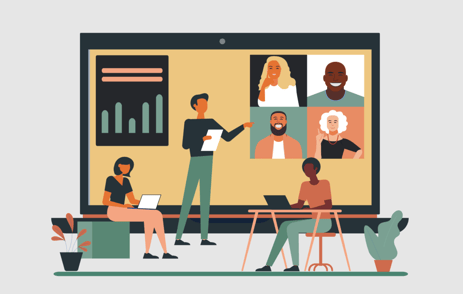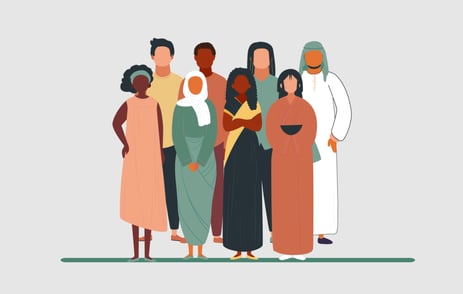Your association or organization might have all the right policies in place. You comply with equal employment opportunity measures, you have multiple demographics represented in your staff, and you have discrimination policies that promote a fair work environment.
Theoretically, you’re checking all the right boxes to make your association membership and staff a diverse and inclusive community.
But are you actually empowering your diverse teams to thrive?
Expert panelists at SURGE said that to be truly diverse, equitable, and inclusive, associations need to dig deeper and be prepared for some uncomfortable conversations. Diversity should be at the heart of the entire organization — not just in HR compliance.
Here’s what leaders can do to not only practice diversity, but to empower it.
What does it mean to empower diversity?
Empowering diversity is about more than compliance and even representation and recruiting. Associations not only need to have diverse voices as part of the conversation, but they also need to create environments that are open, trusting, and empathetic so that community members, staff, and other stakeholders are free to bring their authentic selves to the table.
“At its core, diversity represents the most valuable resource we have on this planet,” said panelist Christopher Urena, chief learning officer of the Endocrine Society. “... It’s an inimitable brain trust, an unparalleled think tank. When you bring together the minds of people from all walks of life who represent various racial and ethnic backgrounds, cultures, religions, experiences, perspectives, and ideas, the opportunities are unbounded.”
Panelist Sheryl McCalla, vice president of strategic initiatives at the American College of Rheumatology, highlighted that when speaking about diversity in the context of associations, it applies to the staff, board members, volunteer leadership, and membership itself. Additionally, diversity refers to both demographic and cognitive diversity, welcoming and empowering not only individuals who look different and come from different backgrounds, but also those with different perspectives, viewpoints, and methods of processing information.
Diversity leads to excellence
Panelists agreed that associations won’t be able to reach their greatest capacity of excellence without diversity.
“Within every demographic category, there are people who are talented and excellent and creative and motivated. Then the question becomes, why wouldn’t there be diversity? If there’s this excellence everywhere, then you should naturally see diversity. It’s a matter of equity if we’re not seeing diversity,” McCalla said.
How can potential be maximized and excellence unlocked if there aren’t individuals present at the table who think and process information differently? Homogenous groups simply don’t have the same spectrum of experiences and perspectives to achieve meaningful excellence.
However, to achieve excellence, those diverse talents need to have all of the available resources.
“It’s one thing to have people welcomed to the table, but I don’t think that’s enough,” Urena said. “As leaders, it’s up to us to support these talented colleagues so that they thrive not only in this organization but also future workplaces and volunteer roles.”
Associations need to be role models in ushering forward best practices
Panelist Marcia Howard, vice president of regulatory affairs for CHPA, urged association leaders to think bigger. “In the association community, we all have the ability to have significant impact on our members, as well as society as a whole.”
It’s important to remember that associations have a much broader impact than just their members. Associations are looked to to identify best practices within the entire industry and beyond. Therefore, they have a responsibility to set an example for society at large. Likewise, even though it may be uncomfortable, associations should stop being afraid of discussing social justice issues that affect our lives. DEI initiatives are too important to gloss over or neglect.
Additionally, panelists said that associations need to be involved in issues of social impact. Members want to know how the organization as a whole plans to address the social issues of today.
Building trust and creating open environments
Howard said her association implemented fireside chats, where every few months, the staff comes together for transparent conversations about their life experiences and upbringing. Through these chats, Howard said her team has forged stronger bonds and deeper, richer connections among colleagues.
“It costs nothing to the staff but their time,” she said.
By building trust, you can create an open environment that empowers teams to feel secure in being their authentic selves and bring forward new ideas, thoughts, and experiences. However, a side effect of this is a little discomfort.
Discomfort is an essential part of growth — after all, how can you not expect differing opinions when you’ve built a cognitively diverse team with people from all different backgrounds?
Panel leader Dr. Barry Barresi, president and CEO of Association Ventures, said team abrasion can be safely managed and tapped to reach highly creative and innovative solutions.
The key is to not be afraid to face these uncomfortable conversations and to not view conflict as a negative outcome. “You don’t get innovation without diversity and conflict,” Howard said. Leaning into potential conflicts will generate the best ideas, she said.
Urena said the best way to approach these fireside chat or town hall situations is to set ground rules from the start. He recommended telling all participants to expect some uncomfortable moments. But this leads to real, authentic conversations that open minds to other points of view.
These kinds of conversations should be hard-wired into the culture of the organization, Barresi said. It’s much more natural to empower a colleague with whom you already share a connection. But again, the key here is to have established trust at the forefront. Without trust, you will miss out on the creative ideas that diverse thinking ushers forth.
“This is something that’s so simple to do. Instead of starting a conversation with your staff member with the business at hand, simply ask how he or she is doing, or ask about their lives. That creates an opening before you jump into the real purpose at hand. And if we do it authentically, they will understand that their leadership cares, and they will reciprocate in their energy and efforts towards the organization,” Howard said.
Key takeaways for empowering diversity
In summary, these are some important takeaways to keep in mind when empowering diverse teams:
- Diversity and excellence are closely intertwined — you don’t have to choose between diversity and excellence, and you can’t truly achieve excellence without diversity.
- Ask tough questions and be ready to answer honestly, such as “do we really believe in diversity?”
- Understand that empowering diversity is a skill that needs to be learned, just like management.
- Celebrate achievements: “There’s nothing like making a positive impact on social good that really energizes an organization,” Barresi said.
- Take diversity further than programmatic compliance and create an open, trusting environment in which all involved feel confident and safe to speak their minds.
Empowering diversity in a meaningful way takes time, learning, and intentionality. It’s a long-term process that requires effort every day, but it’s a practice associations cannot afford to neglect.

July 2, 2021


